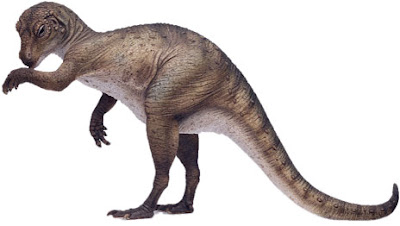
"Heterodontosaurus ("different-teeth lizard") Heterodontosaurids are known only from Lower Jurassic rocks of southern Africa. They were small dinosaurs with a length of 1 to 1.5 meters that had uniquely shaped cheek teeth, chisel-shaped with tiny cusps restricted to the apex of the crown (unique to all dinosaurs). They also had canine-like teeth in the front part of the mouth that had a different shape than the chisel teeth.
- Heterodontosaurus was 1.2 meters long, with short forelimbs and long hind limbs (considered to be bipedal).
- Dental battery set in massive lower jaws and the teeth are usually heavily worn (thus a plant eater).
- Long tail and short neck (typical of primitive ornithischian)
- Ossified tendons in the back region (along the vertebrae)
- Fusion of the fibula and tibia and their fusion to the tarsals, this stabilized the lower leg and ankle for fast running (bird-like feature - example of convergent evolution).
- Hands stout and flexible (perhaps to grasp vegetation)
- Large canines (tusk like)- may have been used for defense and display (this may be a sexual dimorphic feature, some heterodontosaurid skulls lack canines). The canines may also have helped to stabe and tear vegetation.
- Bones found in arid paleoenvironments (deserts and arid alluvial fans).

Description
The Heterodontosaurus was a bipedal/quadrupedal dinosaur. Its diet was low-growing plants. It had three kinds of teeth while most dinosaurs only have one type. The names of the three types are sharp upper front teeth, long canine tusks and high-crowned cheek teeth. It had three toes that faced forward on each foot. They had muscular arms and each hand had three large clawed fingers and two small fingers.
Residence
The Heterodontosaurus was 4 feet (1.2m) long and weighed 5.5 pounds (2.5kg). It lived in South Africa Cape, Province and Lesotho Quthing during the late Triassic and early Jurassic Periods
Male and Female
Adult male Heterodontosaurus have sharp canine like teeth that they most likely used to threaten and/or bite other competing males. Females and young males probably did not have those teeth. Their predators included theropods and crocodilians. While running it was probably on two legs and its tail wagged back and forth furiously unlike later ornithopods whose tail would straight. "

No comments:
Post a Comment